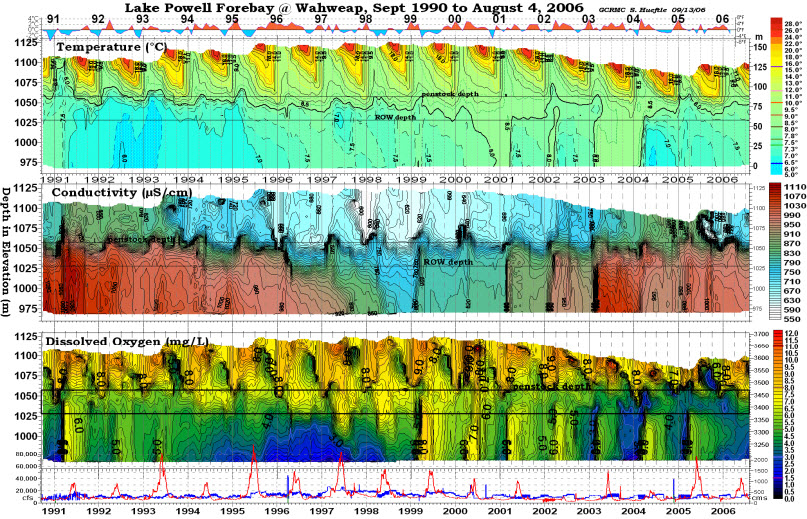|
|
| Line 47: |
Line 47: |
| | |style="color:#000;"| | | |style="color:#000;"| |
| | | | |
| − | The combination of the record five-year drought (1999-2004) and above average runoff into Lake Powell during the spring and summer of 2005 put large amounts of sediment and organic matter from the reservoir's delta into the lake. These substances consumed oxygen as they decay which, in turn, resulted in declining dissolved oxygen concentrations in the Colorado River immediately below the dam. While this phenomenon occurs to some degree every summer and fall, oxygen levels in 2005 reached a level that caused concern for the health of the trout fishery in the river below the dam.
| + | ==2017 Water Quality PEP== |
| − | | + | [[Media:GCMRC QW Review Agenda - Oct 2017 Final.docx| 2017 Water Quality PEP Agenda]] |
| − | As the river moves downstream, the water cascades through rapids, quickly raising the dissolved oxygen levels, so there is less impact or concern for endangered native fish in the reaches of the Grand Canyon. However, there may be some impact to the non-native trout fishery as fish remaining near the dam become lethargic or temporarily move downstream to more oxygen-rich waters.
| + | [[Media:Water Quality Prospectus Final 9-15-2017.docx| 2017 Water Quality PEP Prospectus]] |
| − | | + | |
| − | Reclamation conducted short-term experiments to evaluate the relationship between dam operations and dissolved oxygen concentrations. Researchers from the Grand Canyon Monitoring and Research Center determined if low releases spread among varying numbers of generating units will inject more oxygen into the water. The turbines draw some air during operation, especially when operated at very low output levels. Various operational combinations of three to five units were tested.
| + | |
| − | | + | |
| − | While some changes in dissolved oxygen were been noted as a result of the experiments, a concern also has emerged. Operating the units at very low levels is both inefficient and damaging. Because the generating units were designed to operate efficiently only at higher releases, normal operations for low flows would be met by using fewer units. If the units are operated at too low a level, the risk of damage to the turbines increases significantly. While units have been operated that low in the past for various system and emergency reasons, every effort possible has been made to minimize the length of such operations to protect the generating units. Additionally, such "rough operation" also is inefficient in both the generation of power and the use of water.
| + | |
| − | | + | |
| − | The results of these studies indicate the turbines can contribute to improved dissolved oxygen concentrations in the water being released from the reservoir. The studies remain inconclusive concerning the best balance of turbine operations, or whether other alternatives should be developed.
| + | |
| − | | + | |
| − | The issue of declining dissolved oxygen becomes less of an issue by October or early November when the water in Lake Powell "turns over." This happens when the cooling air temperatures and seasonal winds mix reservoir waters, essentially causing the upper, better oxygenated water to mix with the lower level water that contains low oxygen. [http://www.usbr.gov/newsroom/newsrelease/detail.cfm?RecordID=8041]
| + | |
| | | | |
| | |} | | |} |
